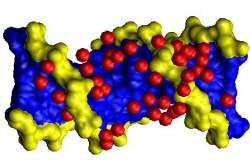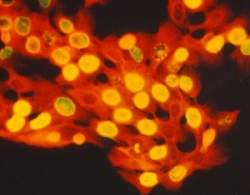 |
| A água tem um papel funcionalmente importante na determinação da estrutura do material genético, moldando as moléculas de DNA. |
Água estrutura DNA
As moléculas de água "abraçam" o DNA de uma maneira muito específica e muito especial, desempenhando um papel até hoje desconhecido.
Cientistas alemães descobriram que, por um lado, a textura dessa camada de hidratação do material genético depende do teor de água e, por outro lado, realmente influencia a estrutura do próprio material genético.
Esta descoberta é importante não apenas para a compreensão da função biológica do DNA - ela também pode ser usada na construção de novos materiais baseados em DNA, uma técnica muito usada pela nanotecnologia, conhecida como origami de DNA.
Ligações de hidrogênio
A dupla hélice do DNA nunca ocorre de forma isolada.
Em vez disso, toda a sua superfície é sempre coberta por moléculas de água, que se ligam ao DNA por meio de ligações de hidrogênio.
Mas o DNA não se liga a todas essas moléculas da mesma maneira.
"Nós fomos capazes de verificar que parte da água está vinculada mais fortemente, enquanto outras moléculas têm uma ligação mais fraca," diz o Dr. Karim Fahmy, do Helmholtz-Zentrum Dresden-Rossendorf (HZDR).
DNA dependente da água
Isto, no entanto, só é verdade se o teor de água for baixo.
Quando a água aumenta de volume, estas diferenças são ajustadas e todas as ligações de hidrogênio tornam-se igualmente fortes.
Isto, por sua vez, altera a geometria da fita de DNA: a espinha dorsal da dupla hélice de DNA, que consiste em grupos de açúcar e fosfato, curva-se ligeiramente.
"A estrutura precisa do DNA depende especificamente da quantidade de água ao redor da molécula", resume Dr. Fahmy.
Nanotecnologia de DNA
Testes com espectroscopia de infravermelho deixaram claro que os componentes de açúcar e os pares de base criam ligações particularmente fortes quando há pouca água, enquanto as ligações entre a água e os grupos fosfato são mais fracos.
"O DNA é, portanto, um material responsivo," explica Fahmy. "Isto se refere a materiais que reagem de forma dinâmica a condições variáveis. A estrutura em dupla hélice, a força das ligações de hidrogênio, e mesmo o volume do DNA, tendem a mudar com um maior teor de água."
O material genético já é visto como uma molécula extremamente versátil e interessante para a chamada nanotecnologia de DNA.
Usando moléculas de DNA, é possível construir estruturas altamente ordenadas, com novas propriedades ópticas, eletrônicas e mecânicas, em dimensões minúsculas.
Função da água no DNA
E a água não é apenas uma parte integrante da estrutura do DNA.
Ela também pode assumir uma função precisa de chaveamento, porque os resultados indicaram que o aumento da camada de hidratação por apenas duas moléculas de água por grupo fosfato pode fazer a estrutura do DNA se "dobrar" instantaneamente.
Tais processos de comutação dependentes da água podem ser capazes de controlar, por exemplo, a liberação de agentes ativos, como fármacos ou medicamentos, a partir de materiais baseados em DNA.





